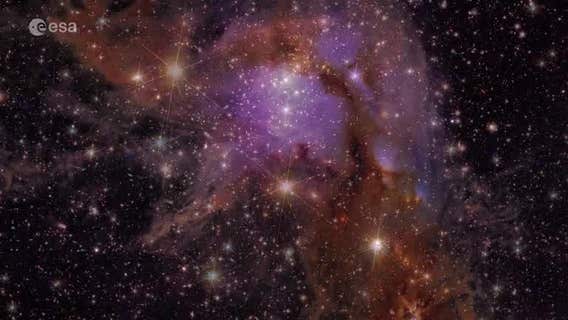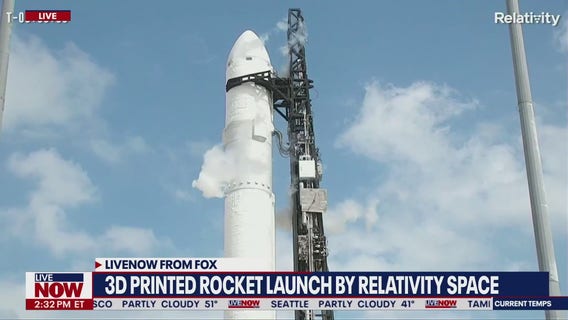Astronomers find 'Tatooine' planet orbiting two stars
The planet is orbiting two brown dwarf stars about 120 light years away.
Solar storms could trigger Northern Lights as far south as Kentucky Tuesday night
NOAA’s Space Weather Prediction Center issued a Geomagnetic Storm Prediction of G3 on the geomagnetic storm scale for early Wednesday morning. The scale goes up to G5.
Blue Origin launches all-female flight with Katy Perry, 5 others: 'Sisterhood'
Blue Origin launched an all-female space flight, which included Katy Perry, Gayle King and Lauren Sanchez, making history as the first all-female space crew since a solo flight in 1963.
New comet spotted: How to see SWAN25F
A new comet was officially designated as C/2025 F2 on April 8.
Full moon 2025: When April’s ‘Pink Moon’ will hit the sky
Wondering when to catch the next full moon? Here’s when the sky will be offering some prime viewing this month.
Watch: Astronaut Suni Williams reunites with her dogs after 9 months in space
“Do you recognize me? Do you know who I am?” she asks as she cuddles her overjoyed dogs outside of her home.
Were they stuck? NASA’s Starliner astronauts finally weigh in
Butch Wilmore and Suni Williams, in their first public comments since returning to Earth, tell FOX News about their thoughts when they found out their short test flight was going to be a lot longer.
Sunrise partial solar eclipse happens Saturday for parts of US
Cities along the I-95 corridor will see a partial eclipse, but it begins before sunrise for places such as Boston, New York, Philadelphia and Washington, which leaves just a few minutes to see this celestial show before it's over.
Ongoing geomagnetic storm increases chances to see Northern Lights again Wednesday
On Tuesday, aurora lights were seen as far south as Central Illinois. Northern lights are possible again on Wednesday as G2 (moderate) geomagnetic storming is forecast.
Watch: SpaceX spy satellite launch leaves otherworldly spiral in the sky
Monday’s SpaceX launch was carrying a classified satellite to space, but the secret payload was not the cause of an unusual glowing spiral seen in the skies of Europe.
How to look back on 10 billion years of cosmic history
The European Space Agency’s Euclid mission launched in 2023 with a goal of studying what is known as the "dark universe."
NJ man's lawsuit claims crew forced him out of plane bathroom, exposing his genitalia
A New Jersey man sued United Airlines and Homeland Security, claiming they forcibly removed him from a bathroom during a flight, exposing his genitalia while he was dealing with constipation.
Northern Lights likely across the north Saturday night amid Geomagnetic Storm Watch
A solar flare erupted from the sun on Friday and is zooming across space, forecast to reach Earth Saturday night and could trigger a geomagnetic storm upon arrival.
NASA's long-overdue astronauts return to Earth
Two astronauts, who spent more than nine months in orbit after a bungled Boeing test flight, have finally said goodbye to their orbiting home.
Photos: Lunar lander gets rare view of eclipse from the moon
While Earthlings were watching the moon turn blood red during Friday morning’s lunar eclipse, a robotic lander on the moon was looking back and getting a very different – and very rare – view.
March's 'Blood Moon' lunar eclipse happens tonight: How to see it
A total lunar eclipse will take place during tonight's Worm Moon, making it a "Blood Worm Moon." Here's how to see it.
SpaceX astronaut launch scrubbed due to technical issue
Two astronauts – whose one-week trip to the space station turned into a nine-month-long politically charged saga – will be spending at least one more day in space.
Where storms could spoil total lunar eclipse Thursday night
The Moon will appear to glow "blood red" on Thursday night and into Friday morning during the total lunar eclipse.
Launch this week clears way for Starliner astronauts to return home 9 months later than planned
NASA astronauts Suni Williams and Butch Wilmore arrived on the space station in June on Boeing Starliner, but Starliner returned to Earth without its crew.
Space Force's mysterious X-37B plane returns to Earth after 434 days in orbit
The unmanned Boeing-made plane landed safely at Vandenberg Space Force Base in California.




















